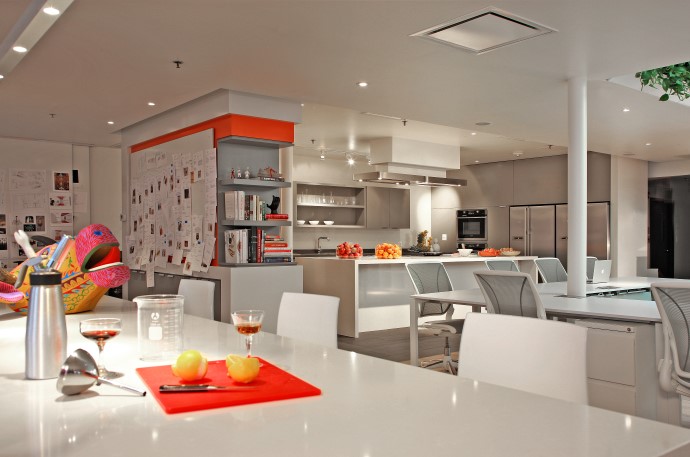
Founded by Chef Jose Andres and partners Rob Wilder and Roberto Alvarez 24 years ago, ThinkFoodGroup has grown from one local restaurant to a global restaurant and food and beverage management organization. Located in a historic building near Washington, D.C.’s Penn Quarter neighborhood, the company occupies two floors. We talked to CEO Kimberly Grant about how this unique and dynamic workplace supports their business goals.
Bob Fox: Let’s begin with an overview of ThinkFoodGroup’s business. Tell us a bit about the company. Your website states that “we pursue the mission of changing the world through the power of food.” How does your workplace support that mission?
Kimberly Grant: The primary purpose of our corporate headquarters is to provide a home for our R&D team to develop future products and business concepts. Our space has the feeling of a creative agency or studio. It is essentially an open office, designed to foster collaboration and interaction. What makes our space unique is that it surrounds our culinary lab. That is where, on a daily basis, our chefs and the creative team come together. The sights, sounds, and activities of both our food and beverage and concept teams provide the sensory and visual stimulation that fosters this creative atmosphere.
Our functional team currently numbers 63 employees. In addition to the R&D team, we have our business support teams, Products, Finance, Marketing, Social Media, Development and Construction, and Procurement. We employ over 1,200 people in our various restaurants and businesses. These range from a mobile food truck to multifaceted hotel Food and Beverage operations at SLS hotels, free-standing restaurants, and our food product line.
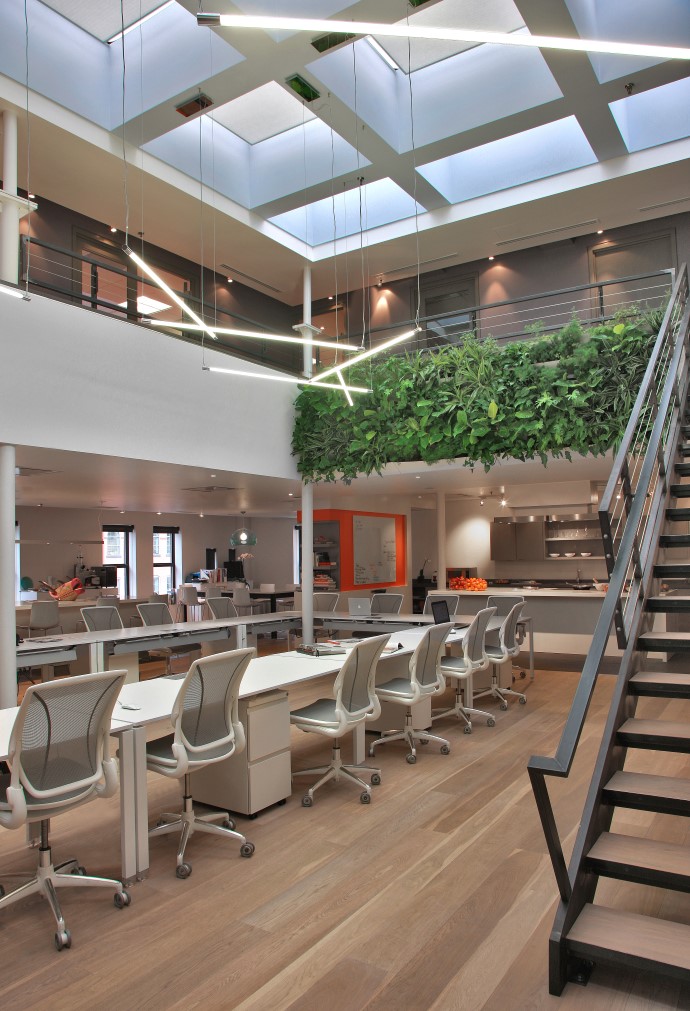
You describe the openness of the space; how does your staff work within the space and around the culinary lab? The lab is certainly a unique aspect of your workspace.
It was very important to have a space that inspired creativity and innovation. Key design elements were selected to make our space bright, open, appealing and attractive. Architectural features include skylights, a green wall, and fun elements such as a foosball table. Jose sits at the head of the main work area, which is set up in a “U” shape configuration. The proximity to the lab allows him immediate access to the other chefs and the R&D team so that all stages of the work process can happen organically throughout the day. You don’t have to set up a meeting to share ideas. When there are activities requiring confidentiality and focus, we have space for that also.
What kind of private spaces do you have to support that kind of work?
Jose has an enclosed office where he can retreat for meetings that require more privacy. His office was designed “lounge style” as he wanted to create an environment where deep and meaningful conversations could occur away from the buzz of activity in the outer office. Our conference rooms have glass walls and were purposely designed to be inviting and open. The conference rooms have custom-designed, interesting tables, not “just office furniture.”
How and where do you do your work?
I admit, I do have an enclosed office. The nature of my work requires me to conduct negotiations and confidential discussions, but, in reality, we are actually in the enclosed offices less than you would think. We try and do as much as we can to be actively involved in the entire office environment and the surrounding neighborhood.
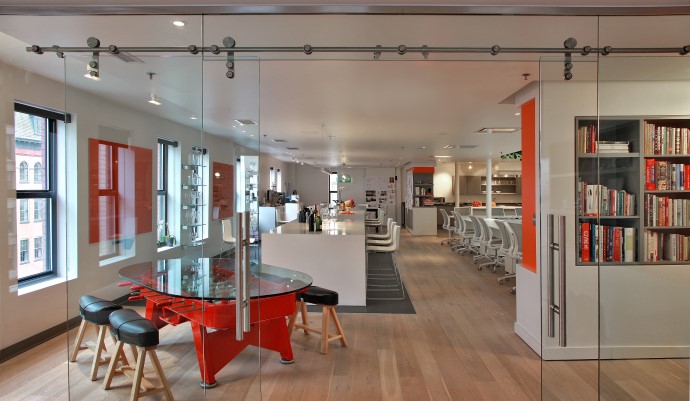
How do you manage that, and how does your building’s location bring additional value to your overall workspace?
The Penn Quarter is an urban environment, yet within the neighborhood we have created our ThinkFoodGroup campus. We are around the corner from five of our highest volume restaurants. In the morning, while walking to the office from the parking garage, I may encounter two or three team members heading out to one of the restaurants. One may be bringing wine; one may be bringing new products to try, others might just be walking out to get a cup of coffee together. Later in the day, on the way to lunch, I will see other co-workers and some of the chefs out and about, moving between the office and the restaurants. It is not a campus in the sense of a Google environment, but it is our campus.
We often have executive team meetings at a nearby coffee shop or even outdoors at a local park. We are a few blocks from the National Mall and other outdoor spaces we can enjoy. A recent Director’s meeting involved 10 of us walking to the Renwick Gallery, which was hosting an exhibit on innovation and creativity. On the way back we could debrief and discuss what we thought about it, in addition to talking about the business at hand. Opportunities like this allow us to take advantage of the neighborhood and surroundings and are a contributing factor to the uniqueness of our entire workplace.
It’s as if the community is just as much a part of the workplace as your offices.
Yes, 100 percent! We are continually trying to figure out additional ways to get away from the confines of the office or add to the variety of spaces we have. We are contemplating adding a podcast studio, a wellness room, and using the roof to provide alternative places to think, create, or just eat lunch.
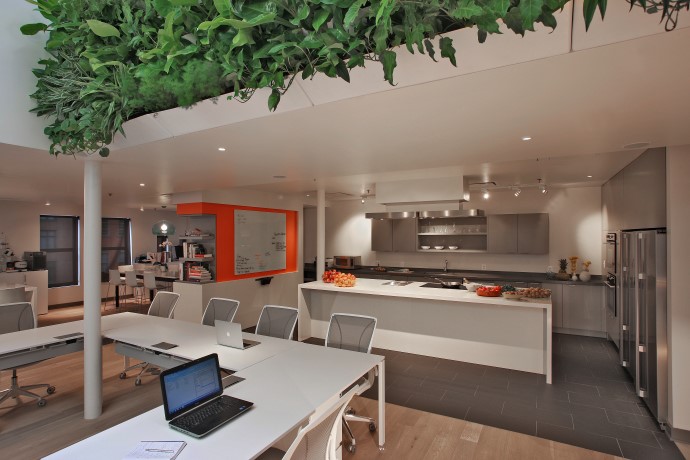
I’m curious. When you talk about getting away from the office, is it just about getting away from the noise or distraction or just looking for a private place?
I think it is more about finding a change of scenery. Sometimes the most creative ideas come when you are not in your everyday setting. We recently had an off-site director level planning meeting. The subject matter sounds mundane, “How to maximize your time at work,” and the plan was to discuss how to achieve work-life balance. The best outcome was the conversations around how we could develop a common language and interact better with each other in our open office setting. We came up with a “red light/green light” language that teams could use to signal availability to interact with others. Each team came up with their own solution. The R&D team uses a light by their desk that operates off their cell phones. If the light is green, you can interrupt. The construction teams, who sit in a workroom with a glass wall, use dry erase markers to put a red flag signal in place when they can’t be disturbed. The marketing team uses Slack when they want to communicate. The off-site experience enabled us to come up with better ways to work together.
What aspects of your workspace do you think help attract and retain staff and project your branding image?
The restaurant industry has a very high employee turnover rate. Therefore, we want to make sure our space is “like no place else.” We accomplish this by not only establishing a creative environment, but one that also supports our values of inclusiveness and diversity. Our teams are fully integrated as we all sit together. The flat organization not only facilitates getting the work done but provides a great learning environment. This collaboration is especially valuable when we have projects with tight deadlines, and we need a variety of input across multiple teams. Working this way helps avoid the typical silos that can occur when there is a lack of immediate proximity from one team to another.
The culinary lab seems to be the heart and soul of your office space. Tell us about some of the interactions that take place there and how that enhances the overall work experience.
The primary users are the Research and Development team. Each day they have an agenda which may include several different activities. We also use the lab for guest tastings or vendor product demonstrations. Occasionally we close down the office for private events. We can easily transform the office into many different kinds of event settings.

It sounds like your office space significantly contributes to your business plans and growth and supports how your team(s) can do their best work. Can you share any thoughts about that?
Our work is extremely visual. At any given time we may be working on eight or 10 development projects. As you walk through the office, you will see us “mind mapping.” For example, we will “mind map” menus. A new concept will start off with a visual display of ideas, pictures, and inspirations that the research and development team may have for menu items. There may be up to 200 images on the board. It may show different categories and directions we can take a menu. As the project progresses, the team culls the items. Off to the side, you will start seeing material items we may consider for the new concept. This process may be similar to how a design firm works as a project progresses.
Where do you find the biggest value your space provides for your employees?
I would say our diversity is what our employees value most. It is not something we are purposeful about; it just happens naturally. We have an energetic, diverse working environment, and the physical space supports that dynamic. I think what they love most is the ability to collaborate with their co-workers easily. Constant exposure to new and different ideas is something that we all enjoy and value.
You describe a very lively environment with a lot of your employees flowing in and out of the office. Do you also have a lot of people who work remotely?
We do not have a lot of remote workers, but many of us travel quite a bit. Of the 63 staff based at our headquarters, maybe 30 or 40 of them are traveling. We may have people in Miami, Los Angeles, Las Vegas, or Mexico City on any given day. Our local operations team is also in and out during the day. We do not have a typical start and a stop time. We seem to have staggered arrival times. The finance team may get in at 6 or 6:30 AM, the marketing team at 9 AM, the operations team at 10 or 11 AM. The beverage team may be in the office until after 10 PM. There is a fluidity to the day. There is no fixed 9-5 schedule.
With such a distributed workforce how do you all keep in touch? Are there any specific tools or technologies that facilitate your communication?
It depends on individual preference, but Slack seems to be one of the top tools. Basecamp is another communication tool our people utilize. We use Dropbox for large image files. We are trying very hard to eliminate email. We use WhatsApp and Skype for meetings. With such a high concentration of travelers, we try and leverage as much technology as possible.
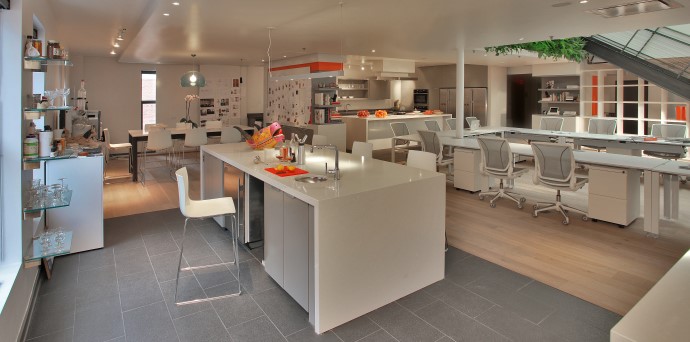
How do you like to communicate with your team and co-workers?
I still use email and text messaging, but I have started to use my calendar to manage due dates and deadlines. Instead of sending emails, I will send a calendar invite with a task and due date in the subject line. Using my calendar to communicate not only helps track the task, it keeps the person I ask to do something informed as well. Moving things to my calendar helps reduce emails and task lists.
What is the impression of your business that affects visitors when they walk into your offices? How does your space convey the message you want to send about what you do and how you work?
Visitors to our headquarters see the brightness and uplifting nature of our office. Everyone always smiles when they first enter the space. We hope the message, especially to potential employees, is that “you have to know that you will enjoy working in this office environment.” We think that those coming from a traditional workspace need a different skill set to be able to be effective in the space we have created. A visitor will see the openness and collaborative environment. A potential employee needs to see how the activity around them will impact their work day. When bringing on new employees, we make sure that they understand the culture of our organization and how that informs the design of our workspace.
Do you capture any performance metrics to evaluate how your space affects the business?
We use a Gallup based employee satisfaction survey once a year. The survey measures employee engagement and goes out to all of our employees. We find that with our open environment and high level of collaboration, our headquarters staff makes us aware of their workspace needs on a continuing basis. That is how we have been able to identify gaps in what we currently provide. The need for a wellness room, for example, came out of conversations that occur every day. That feedback generated the discussion at an executive level about the advisability and fiscal issues around adding new space.
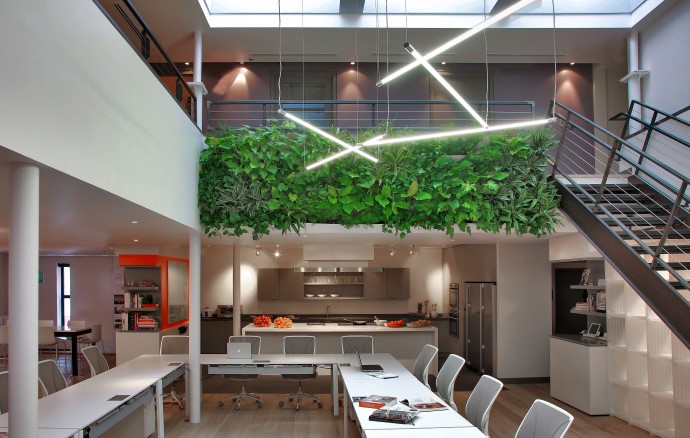
Based on your response it, it sounds like your space is a critical tool to the success of your organization and the way your people interact and share ideas.
Yes, I would agree. We don’t have any specific questions about our workspace on the survey, but perhaps that is something we can consider in the future. The work environment is critical to team’s happiness, and that supports our ability to keep and retain staff.
Is there anything that I didn’t touch on that you would like to share or elaborate on about your workplace?
This topic may not be the focus of your article, but I think a lot of companies talk about diversity. They have diversity initiatives and programs to encourage and manage that aspect of their business. We have been able to maintain a diverse, inclusive and open workgroup because it’s in our DNA and culture. I like to say that “We work hard on it without working hard on it.” Even before I arrived 3 ½ years ago, we had a significant number of women in the office. In addition to gender diversity, we have age, language, and cultural diversity.
I think that is a very important point and I think the message there is that your mission of embracing diversity is aligned and supported by the space you have created.
Agreed, when you see it, when you look around, you just feel it. It’s a great environment.


